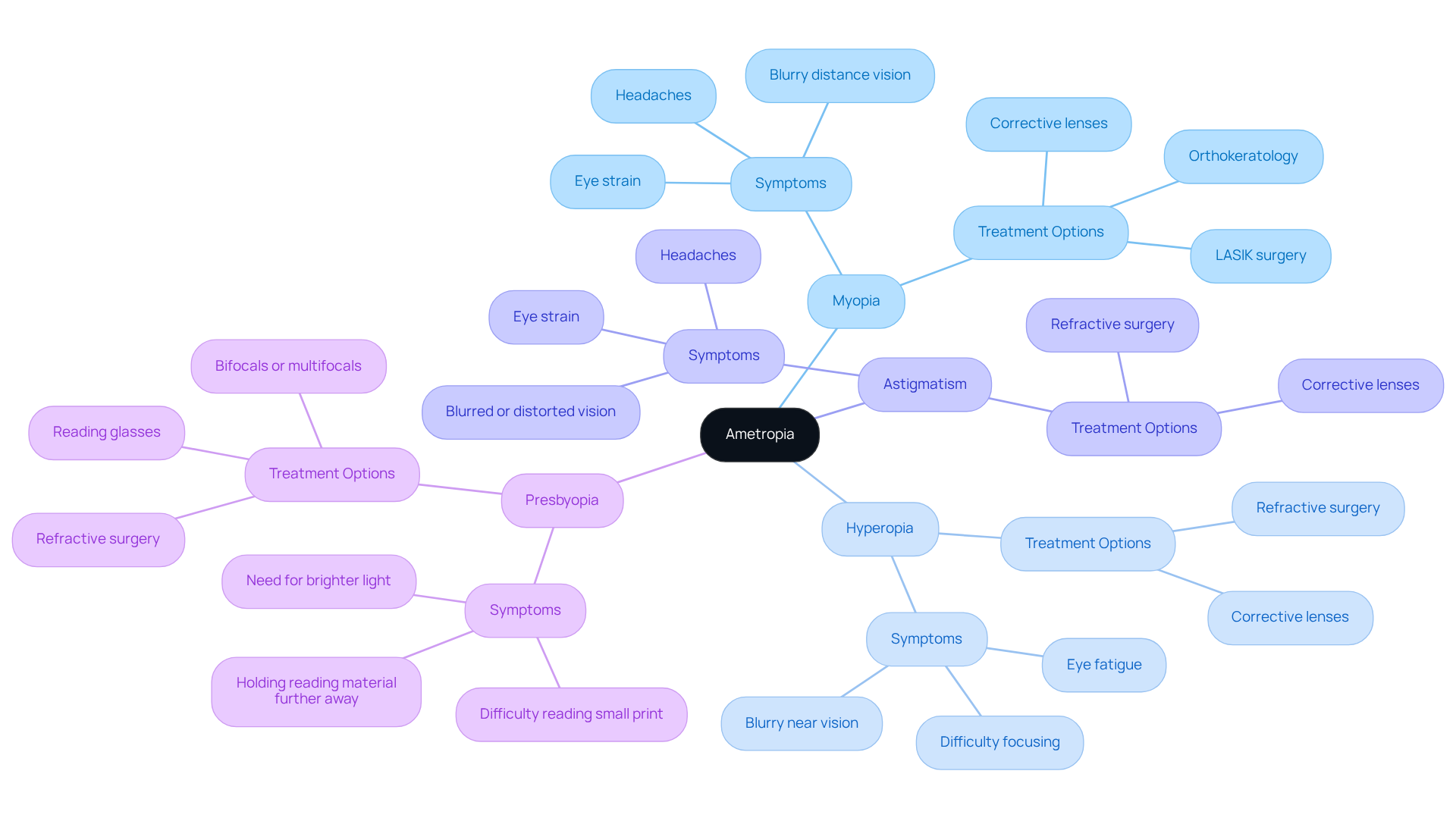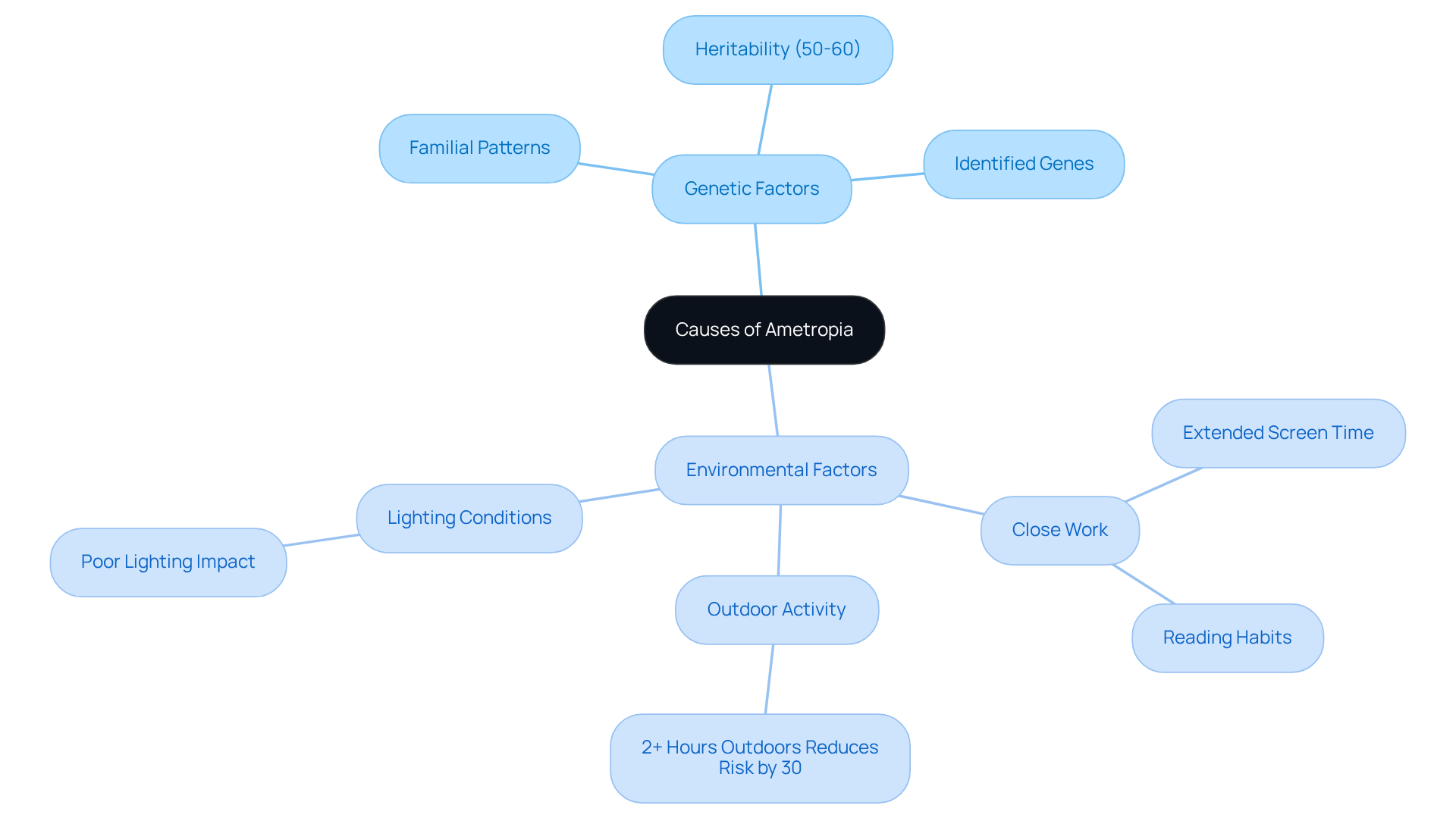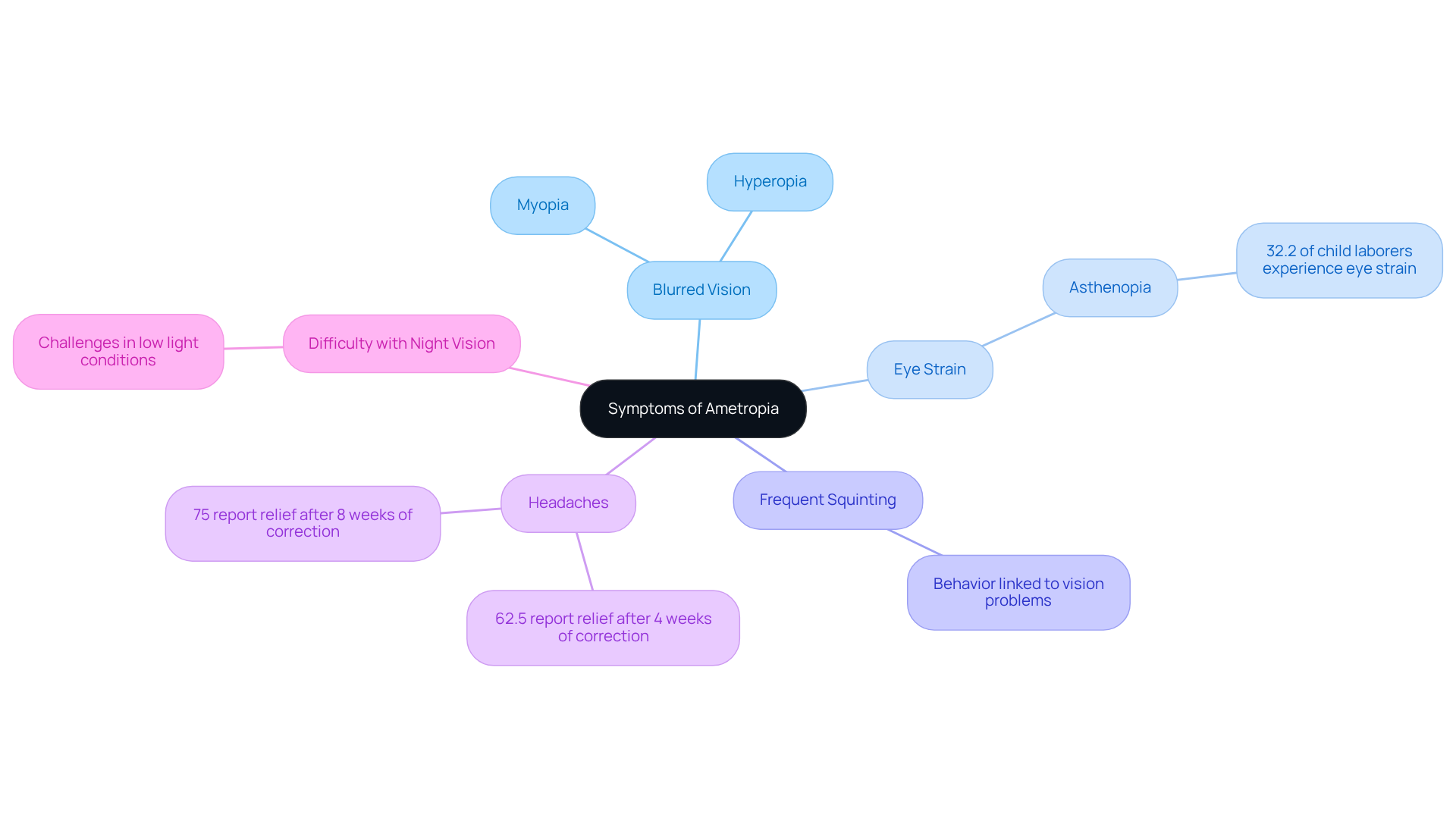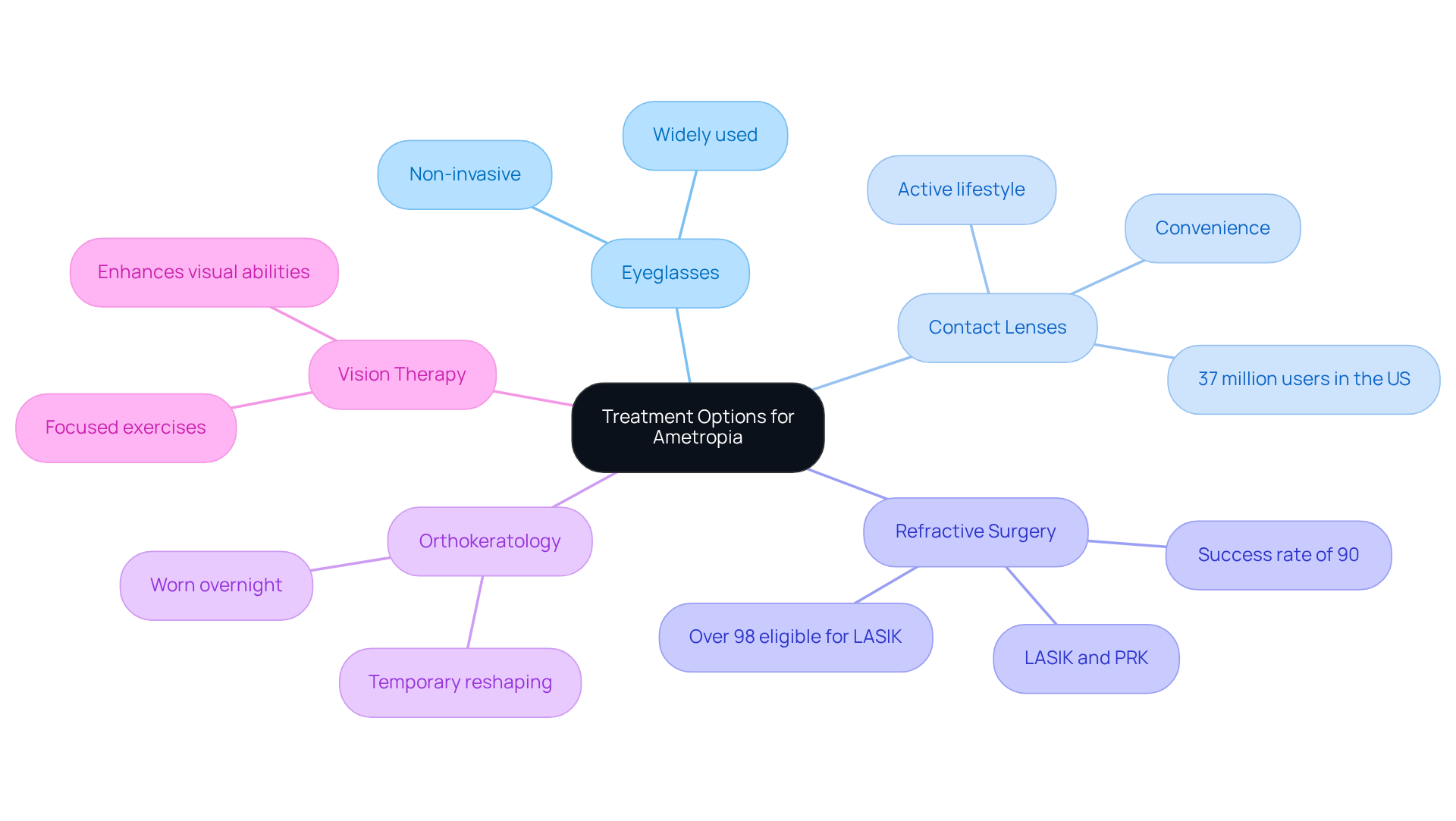Posted by: Northwest Eye in General on August 7, 2025
Overview
Ametropia is a condition that many people may feel concerned about, and it’s important to understand its causes. Primarily, it arises from a combination of genetic predisposition and environmental factors. This can lead to various refractive errors, such as myopia, hyperopia, and astigmatism.
We recognize that genetics play a significant role, accounting for a large portion of myopia cases. However, it’s also essential to acknowledge the impact of environmental influences. For instance, excessive close work and a lack of outdoor activity can contribute to the development of these visual disorders.
It’s common to feel overwhelmed by this information, but remember, understanding these factors is the first step towards addressing your concerns. We are here to help you through this process and provide the support you need.
Introduction
Ametropia, a term that encompasses various refractive errors, can create significant challenges to clear vision and daily life. We understand how frustrating it can be when your eyesight isn’t as clear as it should be.
Understanding the causes, symptoms, and treatment options for this condition is crucial for anyone seeking to improve their eye health.
As the prevalence of ametropia continues to rise, driven by both genetic and environmental factors, the urgency to address these vision issues becomes even more pressing.
It’s common to feel overwhelmed by these changes. What steps can individuals take to recognize the signs of ametropia early and choose the most effective treatment to regain clarity in their vision?
We are here to help you through this process.
Define Ametropia: Understanding the Basics
Ametropia refers to a medical term that describes a group of visual disorders characterized by refractive errors in the eye. We understand that dealing with vision issues can be concerning. In a healthy eye, light rays focus directly on the retina, allowing for clear vision. However, when visual disorders like ametropia occur, this focus is disrupted, leading to blurred or distorted images. Ametropia includes common types of refractive errors such as:
- myopia (nearsightedness)
- hyperopia (farsightedness)
- astigmatism
- presbyopia
Recognizing these vision disorders is essential for understanding their symptoms and exploring effective treatment options. We are here to help you through this process.

Identify Causes of Ametropia: Genetic and Environmental Factors
A complex interplay of genetic and environmental factors leads to the development of ametropia. We understand that concerns about vision can be overwhelming, and it’s important to know that ametropia is significantly influenced by genetic predisposition. For instance, certain conditions, like myopia, often show familial patterns. Research indicates that genetics account for 50-60% of myopia cases, underscoring its heritable nature. Numerous genes associated with myopia have been identified, further emphasizing the genetic aspect of refractive errors.
However, environmental factors are equally crucial in the discussion of ametropia. Extended close work, such as reading or significant screen time, has been linked to a higher risk of developing ametropia. It’s common to feel anxious about how daily habits might affect eye health. Studies reveal that children engaging in more than three hours of close-up tasks daily face a heightened risk of developing myopia. Additionally, inadequate outdoor activity increases the risk of developing ametropia; children who spend less time outside are more prone to encounter vision issues. For example, children who enjoy 2 or more hours outdoors daily can lower their risk of myopia by 30%.
Moreover, poor lighting conditions can contribute to visual strain, impacting eye health. Understanding these environmental aspects empowers you to take proactive steps. We encourage you to increase outdoor time and minimize screen exposure to lessen the risk of developing vision problems. By making these small changes, you can help protect your eyes and promote better vision health.

Recognize Symptoms of Ametropia: Signs to Watch For
Signs of ametropia can appear in various ways, depending on the type and severity of the vision problem. It’s important to be aware of common signs that may indicate a problem:
- Blurred vision: This can happen when looking at distant objects (myopia) or close objects (hyperopia), which can significantly disrupt daily activities.
- Eye strain or discomfort: Prolonged reading or screen time often leads to discomfort, known as asthenopia. This is particularly common among individuals with uncorrected refractive errors. In fact, studies show that excessive near work resulted in asthenopia for as many as 32.2% of child laborers.
- Frequent squinting: Many people find themselves squinting to see clearly, a behavior often linked to vision problems.
- Headaches: These can frequently occur due to eye strain and may be concerning. Research indicates that after addressing refractive errors, 62.5% of children reported relief from headaches within four weeks, and 75% experienced relief after eight weeks.
- Difficulty with night vision: Individuals may find it challenging to see in low light conditions, a situation that can be worsened by certain types of ametropia.
Recognizing these symptoms early is crucial. Timely intervention can lead to effective treatment and a better quality of life. Eye care specialists emphasize the importance of routine eye check-ups, especially for children. A significant percentage of those experiencing unexplained headaches may have underlying vision issues. As optometrist John Dreyer notes, “Refractive issues should be taken into account in the differential diagnosis for children presenting with unexplained headaches.” By addressing refractive errors promptly, patients can avoid potential complications and improve their overall visual health. We understand that seeking help can feel daunting, but remember, we are here to support you through this process.

Explore Treatment Options for Ametropia: From Glasses to Surgery
Treatment options for ametropia are specifically tailored to address the type and severity of refractive error, ensuring that each individual receives the most suitable care. We understand that navigating these options can feel overwhelming, but several effective approaches are available to help you regain clarity in your vision:
- Eyeglasses: As the most prevalent and non-invasive method, prescription lenses focus light accurately on the retina, making them a reliable choice for many.
- Contact Lenses: Offering a broader range and enhanced convenience, contact lenses are an excellent option for those with active lifestyles. With approximately 37 million Americans using them, their popularity speaks volumes.
- Refractive Surgery: Procedures like LASIK and PRK reshape the cornea, providing a permanent solution for refractive errors. LASIK surgery boasts an impressive success rate, with about 90% of patients achieving 20/20 eyesight or better. Furthermore, over 98% of individuals who wear glasses or contacts may be eligible candidates for LASIK, making it a highly desired choice.
- Orthokeratology: This non-surgical technique uses specially crafted contact lenses worn overnight to temporarily reshape the cornea, allowing for clear sight during the day without the need for glasses or contacts.
- Vision Therapy: In certain cases, focused exercises may be recommended to enhance visual abilities and alleviate symptoms related to refractive errors.
Each treatment option offers unique benefits, and we encourage you to engage in a thorough consultation with an eye care professional to determine the best approach for your individual needs. With advancements in technology and techniques, you have access to a variety of effective solutions that can significantly enhance your vision and quality of life. It’s important to note that vision disability ranks among the top 10 disabilities in adults over 18, underscoring the significance of addressing ametropia and pursuing appropriate treatment options. At Northwest Eye, we bring extensive experience and have performed over 2.5 million procedures, positioning us to provide you with tailored solutions that truly meet your needs. We are here to help you through this process.

Conclusion
Ametropia encompasses a range of refractive errors that can significantly impact your vision quality. We understand that navigating visual health can feel overwhelming. By learning about ametropia and its associated conditions—such as myopia, hyperopia, astigmatism, and presbyopia—you can take important steps towards better vision health. This knowledge is crucial not only for recognizing symptoms but also for seeking timely and effective treatment options.
The article highlights the multifaceted causes of ametropia, emphasizing both genetic predispositions and environmental influences. It’s common to feel concerned about factors like excessive close-up work and limited outdoor activity, which play a significant role in the development of these visual disorders. Recognizing symptoms such as blurred vision, eye strain, and headaches can lead to early intervention, which is essential for maintaining optimal eye health. Various treatment avenues, including eyeglasses, contact lenses, and surgical options like LASIK, provide tailored solutions to improve vision clarity.
Addressing ametropia is vital for enhancing your quality of life and preventing further complications. By staying informed about the causes, symptoms, and treatments available, you can take proactive steps towards better vision health. We encourage you to engage with eye care professionals and prioritize regular check-ups. This will empower you to make informed decisions, ensuring that your vision remains clear and vibrant.
Frequently Asked Questions
What is ametropia?
Ametropia is a medical term that describes a group of visual disorders characterized by refractive errors in the eye, leading to blurred or distorted images.
How does ametropia affect vision?
In a healthy eye, light rays focus directly on the retina for clear vision. Ametropia disrupts this focus, resulting in vision issues.
What are the common types of ametropia?
Common types of ametropia include myopia (nearsightedness), hyperopia (farsightedness), astigmatism, and presbyopia.
Why is it important to recognize ametropia?
Recognizing ametropia is essential for understanding its symptoms and exploring effective treatment options.






